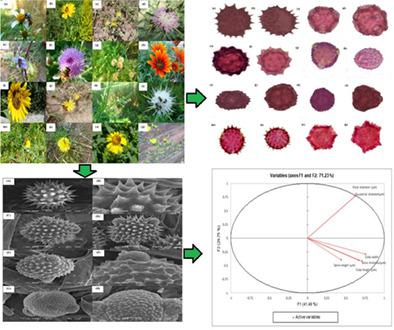当前位置:
X-MOL 学术
›
Microsc. Res. Tech.
›
论文详情
Our official English website, www.x-mol.net, welcomes your
feedback! (Note: you will need to create a separate account there.)
Palynomorphological diversity among the Asteraceous honeybee flora: An aid to the correct taxonomic identification using multiple microscopic techniques
Microscopy Research and Technique ( IF 2.0 ) Pub Date : 2021-09-18 , DOI: 10.1002/jemt.23932 Nabila 1 , Mushtaq Ahmad 1 , Muhammad Zafar 1 , Saraj Bahadur 2 , Shazia Sultana 1 , Sehrish Taj 3, 4, 5 , Ferhat Celep 6 , Salman Majeed 1 , Rozina 1
Microscopy Research and Technique ( IF 2.0 ) Pub Date : 2021-09-18 , DOI: 10.1002/jemt.23932 Nabila 1 , Mushtaq Ahmad 1 , Muhammad Zafar 1 , Saraj Bahadur 2 , Shazia Sultana 1 , Sehrish Taj 3, 4, 5 , Ferhat Celep 6 , Salman Majeed 1 , Rozina 1
Affiliation

|
This study aimed to characterize the palynological morphology of melliferous species of family Asteraceae belonged to seven tribes which were categorized into 15 genera and were studied under light and scanning electron microscopy. The pollen grains were acetolyzed, measured, and described qualitatively. Quantitative data were analyzed by descriptive and multivariate statistical analysis. The species were analyzed considering 11 quantitative pollen characteristics. The study revealed that the pollen grains are circular, triangular, angular, semi-angular, quadrangular, pentagonal and hexagonal amb, and 3-colporate or 3-colpate. The size of the pollen is variable among the species, ranged from 56.1 to 23.2 μm. Three pollen types: oblate spheroidal (eight species), prolate spheroidal (six species), and suboblate (two species) were observed. The surface pattern of the exine varies from echinoperforate, echinate, echinate microperforate, fenestrate, echinoperforate reticulate, microreticulate, echinate perforate, tectate, and scabrate. Exine thickness was calculated minimum in Cichorium intybus (2.47 μm) and maximum in Taraxacum campylodes (5.15 μm). A key to studied bee floral species, based on the morphological features of pollen grains, is also provided. The palynomorphological characters here analyzed can be potentially used to correctly identify the Asteraceous honeybee floral species most commonly plants visited by honeybees in the study area.
中文翻译:

菊科蜜蜂植物群的孢粉形态多样性:有助于使用多种显微技术进行正确的分类鉴定
本研究旨在表征属于7个部落15个属的菊科植物的孢粉形态,并在光学和扫描电子显微镜下进行了研究。花粉粒被乙酰化、测量和定性描述。通过描述性和多变量统计分析对定量数据进行分析。考虑到 11 个定量花粉特征对物种进行了分析。研究表明,花粉粒有圆形、三角形、角形、半角形、四角形、五角形和六角形,以及3-colporate或3-colpate。花粉的大小因物种而异,范围为 56.1 至 23.2 μm。观察到三种花粉类型:扁球形(八种)、扁长球形(六种)和近扁形(两种)。外壁的表面图案从棘齿、棘齿、棘齿微孔、窗孔、棘齿网状、微网状、棘齿穿孔、tectate 和 scabrate 变化。外壁厚度计算最小值Cichorium intybus (2.47 μm) 和蒲公英中的最大值(5.15 μm)。还提供了基于花粉粒形态特征研究蜜蜂花种的关键。这里分析的孢粉形态特征可以潜在地用于正确识别研究区域蜜蜂最常访问的紫菀蜜蜂花卉物种。
更新日期:2021-09-18
中文翻译:

菊科蜜蜂植物群的孢粉形态多样性:有助于使用多种显微技术进行正确的分类鉴定
本研究旨在表征属于7个部落15个属的菊科植物的孢粉形态,并在光学和扫描电子显微镜下进行了研究。花粉粒被乙酰化、测量和定性描述。通过描述性和多变量统计分析对定量数据进行分析。考虑到 11 个定量花粉特征对物种进行了分析。研究表明,花粉粒有圆形、三角形、角形、半角形、四角形、五角形和六角形,以及3-colporate或3-colpate。花粉的大小因物种而异,范围为 56.1 至 23.2 μm。观察到三种花粉类型:扁球形(八种)、扁长球形(六种)和近扁形(两种)。外壁的表面图案从棘齿、棘齿、棘齿微孔、窗孔、棘齿网状、微网状、棘齿穿孔、tectate 和 scabrate 变化。外壁厚度计算最小值Cichorium intybus (2.47 μm) 和蒲公英中的最大值(5.15 μm)。还提供了基于花粉粒形态特征研究蜜蜂花种的关键。这里分析的孢粉形态特征可以潜在地用于正确识别研究区域蜜蜂最常访问的紫菀蜜蜂花卉物种。











































 京公网安备 11010802027423号
京公网安备 11010802027423号